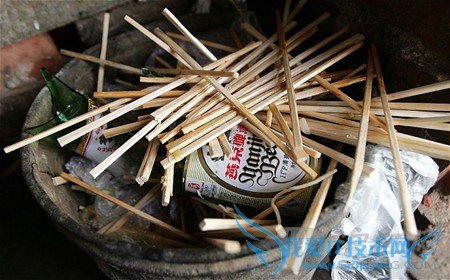��ӭ������52ijӢ��������������С��Ϊ�������Ӣ��֪ʶ�ǣ���Ӣý�������й��˷��������õ���ɣ�������������ϸ�ķ�����
Ӣý�������й��˷��������õ���ɣ�

It is a battle that has divided East and West for centuries: Are chopsticks superior to the knife and fork? Now the debate may finally be decided, on environmental grounds. ���Ӻ��û��ǵ�����ã����Ǽ���������������������һֱ�������һ�����⡣�����ڴӻ����Ƕȳ������ⳡ���ճ־õı����ƺ����ڿ��Գ����䶨�ˡ�
With 1.4 billion people ploughing through 80 billion pairs of throwaway chopsticks each year, China has admitted its forests can no longer provide enough cutlery for its dinner tables.ÿ�꣬14�ڵ��й��˻�ʹ�õ�800��˫һ���Կ��ӣ��й�Ҳ������Ϊ������ɭ����Դ�Ѿ���Ϊ���ǵIJ����ṩ�㹻�Ŀ����ˡ�
"We must change our consumption habits and encourage people to carry their own tableware," said Bo Guangxin, the chairman of Jilin Forestry Industry Group, to his fellow delegates at the National People's Congress.����ɭ�ֹ�ҵ���ŵĶ��³��ع�����ǰ�������ڼ佨�飺������Ӧ�øı�����ϰ�ߣ��������dz��ųԷ�ʱҲ�Լ����;ߡ���
Pointing out that only 4,000 chopsticks can be carved from a 20-year-old tree, he even went so far as to suggest that restaurants offered metal knives and forks instead. If Mr Bo's suggestion is widely adopted, it would be a dark moment in the chopstick's 4,000-year history. ��ָ����һ��20���������ľֻ��������4000˫���ӡ������������飬��Ӧ��ֱ��ʹ�ý����Ƶĵ��������ӡ�����ع��µĽ��鱻�㷺���ã��й�4000����Ŀ�����ʷ���ܾͻ��������ڰ�ʱ�̡���
It was Da Yu, the founder of the Xia dynasty, who is said to have first used two sticks to eat his food in roughly 2100 BC.���ӵ���Դ��Լ�ڹ�Ԫǰ2100�꣬�ij��Ŀ���֮��������˵�ǵ�һ��ʹ����ֻ�������Է����ˡ�
It was an invention born of urgency. In his rush to reach a flood zone, Da Yu did not want to wait for his meat in his wok to cool, instead seizing a pair of twigs and wolfing down his meal.���ӵĵ�������Ϊʱ����ȣ���ʱ��������ȥ��ˮ��ûʱ����Լ���ʳ������������ֱ����������Сϸ֦���̻��ʳ����˷���

Chopsticks quickly became popular around Asia. However Chinese chopsticks are longer than their Korean and Japanese counterparts in order to reach the communal dishes in the centre of the table. Koreans also often use metal chopsticks because of their love of barbecue.���Ӻܿ������������������������й���ʹ�õĿ��ӱȺ����˺��ձ���ʹ�õ�Ҫ������Ϊ��Ҫ�е������м�Ĺ��ˡ���������Ϊ�����տ�������Ҳ����ʹ�ý����ƵĿ��ӡ�
The fork, meanwhile, is said to have been invented by the Romans, but did not become common in northern Europe until the 18th century.���������˵���������˷����ģ�ֱ��18���Ͳ��ڱ�ŷ��������������
Today, however, China is chopping down 20 million mature trees a year to feed its disposable chopstick habit, according to Mr Bo.�����ݰع��µ�˵��������й�ÿ��Ҫ����2000��ų�����ľ������������ʹ��һ���Կ��ӵ�ϰ�ߡ�
Nor can China find enough wood in its own forests. China is now the world's largest importer of wood and even imports chopsticks from America, where a company in Georgia realised that the state's native gum wood would be perfectly suited to make the utensil.���й���ɭ��������Ѿ�û���㹻��ľ������Ӧ�����������й�����������������ľ�Ľ��ڹ�����������Ҫ���������ڿ��ӡ��������ݵ�һ�ҹ�˾��ʾ�����ص�ԭ����ľ�ĺ��ʺ��Ƴɿ��ӡ�
A previous estimate from China's state forestry administration, based on statistics from 2004 to 2009, put the yearly total at 57 billion disposable chopsticks, a much lower sum.����2004�굽2009������ݣ��й�������ҵ�ִ�ǰ�������ƣ��й�ÿ���һ���Կ������ѿ��ܻ�ﵽ570��˫��������ݱ�ʵ������Ҫ�͵öࡣ
- �����б����������۽������ѱ�����˿���������������վͬ����۵��֤ʵ��������
-
